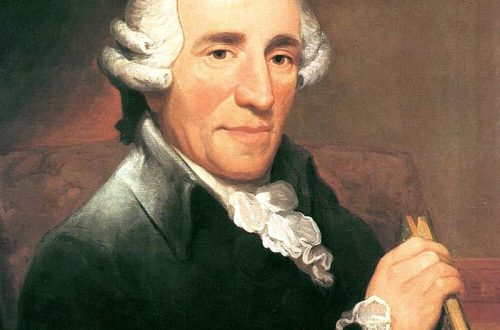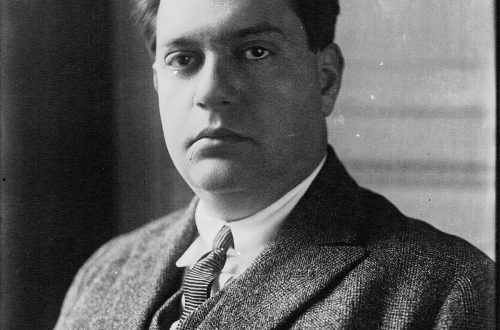
Giovanni Paisiello |
Contents
Giovanni Paisiello

G. Paisiello belongs to those Italian composers whose talent was most clearly revealed in the opera-buffa genre. With the work of Paisiello and his contemporaries – B. Galuppi, N. Piccinni, D. Cimarosa – the period of brilliant flowering of this genre in the second half of the 1754th century is connected. Primary education and the first musical skills Paisiello received in the college of the Jesuits. Most of his life was spent in Naples, where he studied at the San Onofrio Conservatory with F. Durante, a famous opera composer, mentor of G. Pergolesi and Piccinni (63-XNUMX).
Having received the title of teacher’s assistant, Paisiello taught at the conservatory, and devoted his free time to composing. By the end of the 1760s. Paisiello is already the most famous composer in Italy; his operas (predominantly buffa) are successfully staged in the theaters of Milan, Rome, Venice, Bologna, etc., meeting the tastes of a fairly wide, including the most enlightened, public.
Thus, the famous English music writer C. Burney (the author of the famous “Musical Journeys”) spoke highly of the buffa opera “Intrigues of Love” heard in Naples: “… I really liked the music; it was full of fire and fantasy, the ritornellos abounded with new passages, and the vocal parts with such elegant and simple melodies that are remembered and carried away with you after the first listening or can be performed in the home circle by a small orchestra and even, in the absence of another instrument, by the harpsichord “.
In 1776, Paisiello went to St. Petersburg, where he served as court composer for almost 10 years. (The practice of inviting Italian composers had long been established at the imperial court; Paisiello’s predecessors in St. Petersburg were the famous maestro B. Galuppi and T. Traetta.) Among the numerous operas of the “Petersburg” period is The Servant-Mistress (1781), a new interpretation of the plot, half a century back used in the famous Pergolesi opera – the ancestor of the buffa genre; as well as The Barber of Seville based on the comedy by P. Beaumarchais (1782), which enjoyed great success with the European public for several decades. (When the young G. Rossini in 1816 again turned to this subject, many regarded it as the greatest audacity.)
Paisiello’s operas were staged both at the court and in theaters for a more democratic audience – the Bolshoi (Stone) in Kolomna, the Maly (Volny) on the Tsaritsyn Meadow (now the Field of Mars). The duties of the court composer also included the creation of instrumental music for court festivities and concerts: in the creative heritage of Paisiello there are 24 divertissements for wind instruments (some have program names – “Diana”, “Noon”, “Sunset”, etc.), clavier pieces, chamber ensembles. In St. Petersburg religious concerts, Paisiello’s oratorio The Passion of Christ (1783) was performed.
Returning to Italy (1784), Paisiello received a position as a composer and bandmaster at the court of the King of Naples. In 1799, when Napoleon’s troops, with the support of revolutionary Italians, overthrew the Bourbon monarchy in Naples and proclaimed the Parthenopean Republic, Paisiello took the post of director of national music. But six months later, the composer was removed from his post. (The republic fell, the king returned to power, the bandmaster was charged with treason – instead of following the king to Sicily during the unrest, he went over to the side of the rebels.)
Meanwhile, a tempting invitation came from Paris – to lead the court chapel of Napoleon. In 1802 Paisiello arrived in Paris. However, his stay in France was not long. Indifferently received by the French public (the opera seria Proserpina written in Paris and the interlude Camillette were not successful), he returned to his homeland already in 1803. In recent years, the composer lived in seclusion, solitude, keeping in touch only with his closest friends.
More than forty years of Paisiello’s career was filled with extremely intense and diverse activities – he left more than 100 operas, oratorios, cantatas, masses, numerous works for orchestra (for example, 12 symphonies – 1784) and chamber ensembles. The greatest master of opera-buffa, Paisiello raised this genre to a new stage of development, enriched the techniques of comedic (often with an element of sharp satire) musical characterization of the characters, strengthened the role of the orchestra.
Late operas are distinguished by a variety of ensemble forms – from the simplest “duets of consent” to grand finales, in which the music reflects all the most complex vicissitudes of the stage action. Freedom in the choice of plots and literary sources distinguishes Paisiello’s work from many of his contemporaries who worked in the buffa genre. So, in the famous “The Miller” (1788-89) – one of the best comic operas of the XVIII century. – pastoral features, idylls are intertwined with witty parody and satire. (Themes from this opera formed the basis of L. Beethoven’s piano variations.) The traditional methods of a serious mythological opera are ridiculed in The Imaginary Philosopher. An unsurpassed master of parodic characteristics, Paisiello did not ignore even Gluck’s Orpheus (the buffa operas The Deceived Tree and The Imaginary Socrates). The composer was also attracted by exotic oriental subjects that were fashionable at that time (“Polite Arab”, “Chinese Idol”), and “Nina, or Mad with Love” has the character of a lyrical sentimental drama. The creative principles of Paisiello were largely accepted by W. A. Mozart and had a strong influence on G. Rossini. In 1868, already in his declining years, the illustrious author of The Barber of Seville wrote: “In a Parisian theater, Paisiello’s The Barber was once presented: a pearl of artless melodies and theatricality. It has been a huge and well-deserved success.”
I. Okhalova
Compositions:
operas – Chatterbox (Il сiarlone 1764, Bologna), Chinese idol (L’idolo cinese, 1766, post. 1767, tr “Nuovo”, Naples), Don Quixote (Don Chisciotte della Mancia, 1769, tr “Fiorentini” , Naples), Artaxerxes (1771, Modena), Alexander in India (Alessandro nelle Indie, 1773, ibid.), Andromeda (1774, Milan), Demophon (1775, Venice), Imaginary Socrates (Socrate immaginario, 1775, Naples), Nitteti (1777, St. Petersburg), Achilles on Skyros (Achille in Sciro, 1778, ibid.), Alcides at the crossroads (Alcide al bivio, 1780, ibid.), Maid-mistress (La serva padrona, 1781, Tsarskoye Selo), Seville barber, or Vain precaution (Il barbiere di Siviglia ovvero La precauzione inutile, 1782, St. Petersburg), Lunar world (Il mondo della luna, 1783, Kamenny tr, St. Petersburg), King Theodore in Venice (Il re Teodoro in Venezia, 1784 , Vienna), Antigonus (Antigono, 1785, Naples), Trophonia’s Cave (La grotta di Trofonio, 1785, ibid.), Phaedra (1788, ibid.), Miller’s Woman (La molinara, 1789, ibid., original ed. — Love with obstacles yami, or the Little Miller’s Woman, L’arnor contrastato o sia La molinara, 1788), Gypsies at the Fair (I zingari in fiera, 1789, ibid.), Nina, or Mad with Love (Nina o sia La pazza per amore, 1789, Caserta), Abandoned Dido (Di-done abbandonata, 1794, Naples), Andromache (1797, ibid.), Proserpina (1803, Paris), Pythagoreans (I pittagorici, 1808, Naples) and others; oratorios, cantatas, masses, Te Deum; for orchestra – 12 symphonies (12 sinfonie concertante, 1784) and others; chamber instrumental ensembles, в т.ч. посв. великой кн. Марии Фёдоровне Collections of various Rondeau and capriccios with Violin accompaniment for p. fte, composed expressly for SAI The Grand Duchess of all the Russias, и др.





